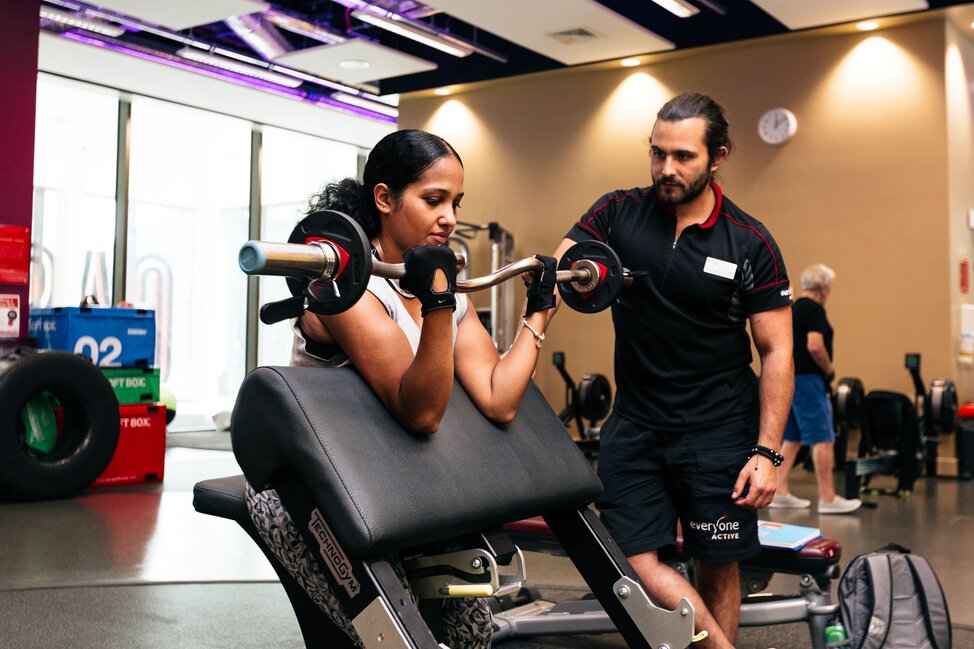
They say that the beginning is always the hardest. This may not apply to absolutely everything in life, but it applies twice as much to fitness. Many people decide to take the first step toward a better self every day. Some of them have to take the first step once a week. Goals and motivations vary but generally have to do with the desire to lose weight or gain muscle mass. Many of us have undoubtedly been driven first by the dream of having an enviable six-pack.
This blog was written by our slim escort girl, who loves going to the gym and being fit!
But perhaps for some of us, this relatively superficial reason could eventually turn into an appreciation of the joy of exercise itself, along with the effort to live a healthier lifestyle. However, the first workouts are usually full of mistakes. Especially when there is no fitness trainer to help you get through the basics, if you are new to the world of fitness, this article will be your ticket. We will give you 10 tips that will help you avoid making unnecessary mistakes and maintain your will and motivation to continue training for a day and a month, or even a year.
Your first steps in the gym, or why start training?
Are you trying to feel better? Dreaming of a beautiful body, like the slim escort girl working with our Escort Agency has? Or are you aiming for a healthier lifestyle that can eventually lead to a longer and healthier life? The beginning of your journey should be based on a solid foundation, based on a good reason to start.
The health benefits of training are more than obvious and affect regardless of age, gender or fitness. The first thing to know is that regular exercise does not lead to a leaner figure or bigger muscles. They have many benefits.
For starters, here are some of the best reasons:
1. More effective weight loss
Training can prevent you from gaining too much weight and increase your ability to lose the excess weight you have already gained. It’s simple: you burn calories as long as you do physical activity. The more intense your workout, the more calories you will burn, and, in general, any physical activity is better than none. This makes strength training especially popular – it can make you burn more energy even a few hours after training. This phenomenon is known as COPD or excessive post-exercise oxygen consumption.
2. Increased chances of living longer
Physical activity of any kind (such as sports) can help you prolong your life. This improves your cardiovascular health and helps you reduce your risk of developing cardiovascular disease. It also positively affects your sleep, strengthens your immune system, and lowers your cholesterol. All these benefits combined have an impact on overall health and longevity.
3. More happiness
Thanks to the increased production of endorphins in the body, exercise improves your mood and reduces anxiety and stress. They also positively affect the production of the hormones serotonin and norepinephrine (norepinephrine), which can alleviate depression.
4. More energy
A study found that within 6 weeks, regular exercise helped participants get rid of their excessive fatigue. Workouts have positive effects on the mitochondria of cells in the body – also known as the energy cushions of the cell, which transform the energy the body needs to function. Ultimately, this can impact your overall energy level and reduce fatigue.
5. Exercise Improves Sleep Quality
A study of the elderly showed that a regular workout program could improve sleep quality and reduce the time it takes to fall asleep. Another study indicated similar results, in which after sixteen weeks of aerobic physical activity, participants who suffered from sleep disorders were found to sleep better, and they were less tired after waking up.
6. Exercise improves heart health
One of the most significant benefits of exercise is that it improves cholesterol levels, lowers blood pressure, and increases the risk of developing cardiovascular disease. The CDC (Centers for Disease Control and Prevention) recommends at least 150 minutes of moderate-intensity physical activity per week. The WHO extends this recommended time to 150-300 minutes of medium-intensity aerobic physical activity and applies this recommendation to all 18 and 64 years. In case of more intense activity, the recommendation is 75 – 150 minutes.
7. Healthier bones
In general, sports are good for bone health. This is because it helps to increase bone density, making bones stronger and slowing down bone loss, which is a natural part of the ageing process. Therefore, exercising regularly, ideally several times a week, is essential instead of only once a month. Bone health benefits include strength training, hiking, walking, tennis, or dancing.
Mistakes are part of life. but you will be much more efficient if you avoid them
The beginnings are often full of mistakes. Many of us have sedentary jobs, sitting behind computers all day. We often go to the gym after work without proper heating. It is pretty common to see beginners looking for heavyweights as soon as they enter the gym. Moreover, many often underestimate proper regeneration and fluid intake, putting all their energy into fixing a weekend in which they drank and ate unhealthily, which often leads to frustration and lack of results. Another common mistake is the amount of time it takes to train, without realizing how much of that time is often wasted accessing apps on smartphones while you’re at the gym.
A particularly insidious enemy of a beginner may be the over-motivation that leads to excessively heavy weights and ignoring proper exercise techniques. This is especially dangerous and can easily lead to lesions.
-
Set your goals INTELLIGENTLY

As soon as you enter the world of gyms, try to set your goals as clearly as possible. If you do this, you will be sure to stay motivated and get the result you want. Your goals should cover several crucial criteria. It is best to follow the well-established SMART method when planning, introducing these critical criteria into your goals. Your goals should be:
Specific
It is not enough to say that you want to lose weight or lift heavier weights. Set specific goals, such as losing 10 pounds, running 10 miles on a track, or lifting 50 pounds on a bench press.
Measurable
If you can’t quantify your goal, you won’t be able to tell how far you’ve come. If your goal is to lose 5 kg, you need to know how much weight you have and consistently track your progress by measuring your weight regularly. Partial successes are great for keeping you motivated and moving toward your ultimate goals.
Achievable
If you aim too high or try to do too much at the same time, chances are you’ll end up failing to reach your goals. Be realistic, be aware of your limitations, and focus on one goal. If you are in a gym for the first time and are not in the best shape, do not expect to lift 100 kg on the bench press, or you will instantly become a champion in knee bending, eclipsing everyone who comes to the gym.
An example of a realistic goal is to expect 20 push-ups with your body weight within 2 months. To achieve your goals, it is advisable to divide them into smaller and more partial goals. It may seem like a lot to lose 4 kg in 2 months, but only 0.5 kg per week does not seem like much, and meeting this goal will eventually lead to the loss of the planned four kilograms.
Realistic
Whenever you choose a goal, you need to think about what you want. Are you preparing for a particular competition? Are you trying to lose weight because you want the suit you chose for a friend’s wedding to come to you? Do you want to be healthier and in better shape? All of these reasons are reasons to stay active. Everyone has to find their own goal. This is the only way to make your goals relevant and sustainable in the long run.
Topical
Time pressure is not a bad idea. Saying that you want to lose 5 kg is not enough. You need to add a time frame to make the goal of “losing or gaining 5 kg in 3 months”. To give you a better idea of setting a realistic time frame, the ideal weight loss rate is about 0.5 to 1 kg per week.
-
Overcome the fear of the gym
If you’re terrified of going to a gym for the first time, you’re not alone. A recent survey found that there are people who do not move at all and roll over the puppet:
- The thought of visiting a gym terrifies them
- Rather than go to a room, they would rather stay in a dark room with a spider.
- Rather than visit a gym, they would give themself an injection.
- Rather than go to the gym, they would instead give up the phone for a day.
- They are insecure when it comes to the gym because they will come across people who look better than them.
- They think of the squat rack as the most excellent device in the room because they don’t know what kind of weights to use.
- They are afraid to ask for help from the room staff.
Many beginners are afraid to be ridiculed when they enter a gym
This is often because I do not know how to use various devices or I do not master the proper technique for exercises. The simple solution to this problem is to ask. Don’t be afraid to ask your staff or coach for help. They will be happy to show you how to use any device. That’s why he’s there, and you can be sure you’re not the first or last person to do that. You’ll be surprised to find that many more experienced gym visitors will be happy to help you during breaks between sets.
Those who go to the gym regularly are very open, and indeed, all those with experience will be happy to help and give you advice. So there’s no point in thinking that someone on the other side is following you. Focus on your goal, every move you make, and if you feel like it, you can get even more help from a pair of headphones with a dynamic playlist.
If you feel stressed about the first group class, talk to your coach in advance

Remember, this is the person whose job is to answer any questions and guide you on your fitness journey. Another thing you can do is watch one of the hours as an observer. In any case, introduce yourself to the coach and don’t be afraid to ask any questions. In addition, you should be familiar with any health restrictions you may have and pass them on to your coach.
To overcome the initial fear of the hall, try to go when the hall is less crowded when it is not crowded. Most people go to the gym between 4 and 7 PM, after work or school. The least crowded is just before noon, during the lunch break, or late in the evening. Go to the front desk and ask when it is busiest and fewer people. Another great strategy is to come with a friend to participate in group training.
Finally, you can prepare by accessing the gym website and social networking sites of your choice. They often offer a lot of images that show the room. You can see what equipment is being used and prepare using various devices at home, inspired by YouTube. In addition, a gym website can give you a lot of helpful information about training, staffing, etc. However, despite all this, the most crucial step as a beginner is to make sure that you participate in the first sessions under the supervision of an experienced fitness trainer.
You can find a room based on references or go straight there
Fitness coaches are primarily employees who work out in the gym, and the front desk staff will be happy to introduce you to them. An experienced instructor will help you overcome your fear very quickly, and most importantly – he will teach you the proper exercise techniques. A personal trainer can be a little more expensive than going to the gym alone, but it’s worth the extra cost, at least for a few start-up sessions. Otherwise, you risk months of ineffective and painful visits to the gym without seeing any progress, and what is worse is that an improper exercise technique can endanger your health, causing injuries.

















































































































































